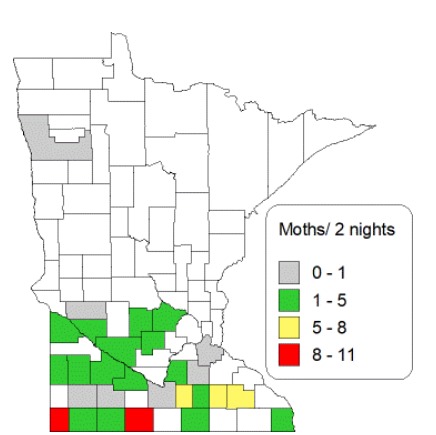By Bruce Potter
The spring of 2023 has been unusual in how long fields remained snow-covered, but throughout much of Minnesota growers have recently made rapid planting progress.
I received my first picture of 2023 emerging corn yesterday. It was a good reminder that crops should be scouted as they emerge.
As snow left the fields, a network of volunteers began monitoring pheromone traps to track the arrival of black cutworm (BCW) moths migrating into Minnesota from the south.
 |
Fig. 1. 2023 black cutworm moth captures (April 7 to May 5).
Shading represents the maximum two-night captures for the
trap(s) in the county. Some counties have more than one trap
and snow-covered fields delayed trap deployment in
some counties. |
Minnesota has been using a trap capture of 8 or more BCW moths over a 2-night period as a significant capture, one indication of increased risk of injury to corn from BCW larvae. A significant capture does not mean economic injury to corn fields is certain, nor do lesser captures indicate no risk, rather significant captures can help provide a start-date for degree-days to begin accumulating and provide an indication of when larvae will be large enough to begin feeding on a corn crop.
So far this spring, most trap captures have been low. Exceptions are significant mid-April captures in Martin County and late-April captures in Rock County (Figure 1, Table 1).
Based on accumulated degree days, BCW eggs from these significant flights should be hatching soon. By the last few days in May, some of the larvae will be large enough to cut small corn below the growing point (Table 1) and impact corn stands. In addition to corn, high BCW larva populations can cause economic stand loss to sugarbeets, soybeans, and other crops.
The pheromone traps provide little evidence of unusually high risk for black cutworm injury this year. However, trap captures have been extremely spotty, and it is possible that there were moth arrivals that were undetected. The southern two tiers of Minnesota appear to be at greatest risk for black cutworm infestations. Weather systems bringing insects from the south were often blocked on the north and channeled eastward. However, BCW risk can change as moths continue to arrive. Weekly updates can be found at https://z.umn.edu/bcw-reporting.
Corn, sugarbeet, and soybean fields worked after May 20 are at lower risk of infestation as tilled fields tend to be less attractive to egg laying BCW moths. Early emerging weeds or cover crops can make a field, or areas of a field, more attractive to egg laying black cutworm moths.
While doing stand counts and weed evaluations, pay close attention to leaf feeding on corn and weeds.
Cutworm ID is important as some species (e.g., dingy cutworm) seldom cut corn below the growing point. For more information on scouting tips and management of black cutworm see https://extension.umn.edu/corn-pest-management/black-cutworm.
Table 1. Projections based on historical average temperatures. Degree day projections from: Midwest Regional Climate Center U2U https://mygeohub.org/groups/u2u/purdue_gdd.

*Less than a significant two-night capture.
1Based on 90 degree-day (base 50F) after significant flight (leaf feeding begins).
2Based on 312 degree-days (base 50F) from significant flight.
4th - 6th instar larvae are large enough to cut corn. Small plants (e.g. sugarbeets) can be cut earlier.
3Based on >641 degree-days (based 50F) after signficant flight pupation.
True armyworm tracking
While not as comprehensive as the BCW network, cooperators’ pheromone traps are also tracking true armyworm moths. As is typical for Minnesota, the 2023 captures are very sporadic. A complicating factor is that armyworm problems do not always occur in the same area as a high trap capture.
Most 2023 captures have been relatively low, but an Olmsted County trap captured 33 moths from May 5 to 8. The Olmsted trap reinforces the need to carefully scout corn planted into a cereal rye cover for armyworms before the rye is terminated.
In addition to spring pheromone trap results, watch the UMN blacklight trap reporting network (https://vegedge.umn.edu/weekly-moth-flights) for armyworm moth captures.
For scouting and management tips for armyworms see https://extension.umn.edu/corn-pest-management/armyworm.
Source : umn.edu